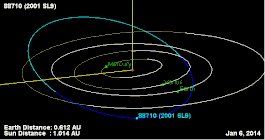(88710) 2001 SL9
(88710) 2001 SL9 is a sub-kilometer asteroid and binary system, classified as near-Earth object of Apollo group[1] discovered by NEAT at Palomar Observatory on 18 September 2001. It measures approximately 960 meters in diameter, while its 2001-discovered minor-planet moon has an estimated diameter of 200 meters based on a secondary to primary mean-diameter ration of 0.28.[2]
 Orbit of 2001 SL9 | |
| Discovery[1][2] | |
|---|---|
| Discovered by | NEAT |
| Discovery site | Palomar Obs. |
| Discovery date | 18 September 2001 |
| Designations | |
| 2001 SL9 | |
| Orbital characteristics[1] | |
| Epoch 13 January 2016 (JD 2457400.5) | |
| Uncertainty parameter 0 | |
| Observation arc | 22318 days (61.10 yr) |
| Aphelion | 1.3480 AU (201.66 Gm) |
| Perihelion | 0.77471 AU (115.895 Gm) |
| 1.0613 AU (158.77 Gm) | |
| Eccentricity | 0.27006 |
| 1.09 yr (399.37 d) | |
| 239.06° | |
| 0° 54m 5.112s / day | |
| Inclination | 21.900° |
| 202.86° | |
| 329.30° | |
| Known satellites | 1 |
| Earth MOID | 0.197987 AU (29.6184 Gm) |
| Jupiter MOID | 3.64009 AU (544.550 Gm) |
| Physical characteristics | |
Mean diameter | 1 km (0.62 mi)[3] |
| Mass | 109 mt |
Mean density | 1.8 g/cm3[2] |
Equatorial surface gravity | 0.02565 mm/s2[4] |
Equatorial escape velocity | 0.05116 mm/s[4] |
| 2.4004 h (0.10002 d) | |
| 2.40035±0.00005 hours[1][5] | |
| 0.16[2] | |
| Temperature | 230-303 K (-43-30°C)[4] |
| 17.6[1] | |
Near-Earth asteroid
Although 2001 SL9 is classified as a near-Earth object, it does not pose any threats. It has never, nor will it ever in the next century, come closer than 15,000,000 km (0.1 AU) from Earth or Venus.[1] However, the asteroid would make a good target for a spacecraft flyby, as a flyby to 2001 SL9 would only require a delta-v of 5.4 km/s.[6]
Moon
2001 SL9 has one minor-planet moon, S/2001 (88710) 1. It was discovered from lightcurve observations[6] made by Czech astronomer Petr Pravec and collaborators.[2] This moon is approximately 200 m (660 ft) in diameter. Its semi-major axis is 1.6 km (0.99 mi) and its orbital period is 16.4 hours.[2]
References
- "88710 (2001 SL9)". JPL Small-Body Database. Jet Propulsion Laboratory. SPK-ID: 2088710. Retrieved 7 April 2016.
- Johnston, Robert (1 September 2005). "(88710) 2001 SL9". Johnston Archive. Retrieved 26 December 2013.
- "Asteroids Do Have Satellites". Asteroids III. 2002. Bibcode:2002aste.book..289M.
- "HEC: Exoplanets Calculator". Planetary Habitability Laboratory. University of Puerto Rico. Archived from the original on 5 September 2019. Retrieved 27 December 2013.
- Green, Daniel (3 November 2001). "IAUC 7742: 2001fd; 2001fe; 2001 SL_9". International Astronomical Union. Harvard University. Retrieved 27 December 2013.
- Benner, Lance (14 December 2004). "BINARY NEAR-EARTH ASTEROIDS DETECTED BY RADAR". Jet Propulsion Laboratory. Archived from the original on 20 September 2020. Retrieved 30 December 2013.
External links
- Lightcurve plot of (88710) 2001 SL9, Palmer Divide Observatory, B. D. Warner (2001)
- Asteroids with Satellites, Robert Johnston, johnstonsarchive.net
- Asteroid Lightcurve Database (LCDB), query form (info Archived 16 December 2017 at the Wayback Machine)
- Dictionary of Minor Planet Names, Google books
- Asteroids and comets rotation curves, CdR – Observatoire de Genève, Raoul Behrend
- Discovery Circumstances: Numbered Minor Planets (85001)-(90000) – Minor Planet Center
- (88710) 2001 SL9 at NeoDyS-2, Near Earth Objects—Dynamic Site
- (88710) 2001 SL9 at ESA–space situational awareness
- (88710) 2001 SL9 at the JPL Small-Body Database